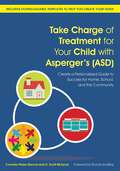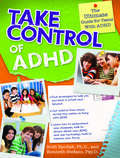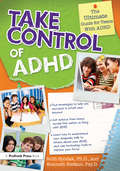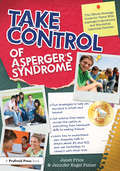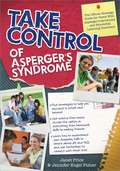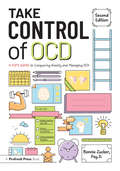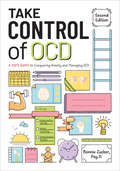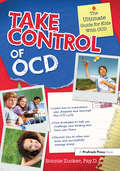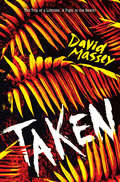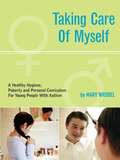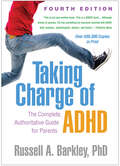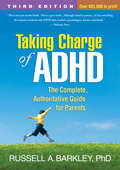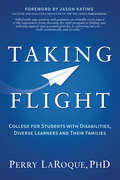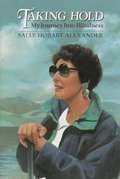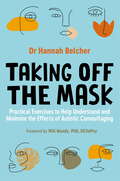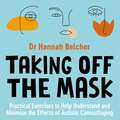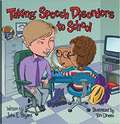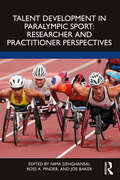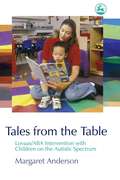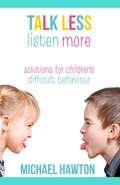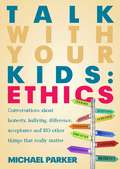- Table View
- List View
Take Charge of Treatment for Your Child with Asperger's (ASD): Create a Personalized Guide to Success for Home, School, and the Community
by Shonda Schilling Cornelia Pelzer Elwood D. Scott McleodEquipping you with the knowledge and tools to become an effective case manager for your child, this book provides straightforward, practical instructions to create a comprehensive guide to your child's unique ASD profile. The individualized guide will: - Provide information about your child's unique profile for anyone who needs it - Serve as a toolbox and teaching template for your child's teachers and support team, with effective strategies to use with him or her - Be an instruction booklet for your child, helping him or her to thrive at home, school and in the community - Act as a case management road map to help you support your child and collaborate with teachers and service providers. The book includes checklists and worksheets, which can also be accessed online, so that you can easily create a personalized guide for your child with autism aged 5-14.
Take Charge: A Strategic Guide for Blind Job Seekers
by Diane Croft Rami RabbyProvides guidance for blind job seekers.
Take Control of ADHD
by Ruth Spodak Kenneth StefanoTake Control of ADHD: The Ultimate Guide for Teens With ADHD is the ultimate handbook for teens with ADHD to help them take control of their disorder and find success in school and in life. By creating the "ADHD Action Plan" discussed in the book, readers will recognize how ADHD affects them, discover coping strategies and technology tools to improve their focus, and develop a self-advocacy plan they can use immediatelyThe book presents the latest research and information on ADHD in a conversational style that teens can understand easily, allowing them to develop a better understanding of their disorder. By including suggestions from teens with ADHD, the authors offer tons of advice, information, and ideas for students, from students just like them. This handy guidebook is sure to help teens with ADHD learn to refocus their attention and find success in school and beyond!
Take Control of ADHD: The Ultimate Guide for Teens With ADHD
by Ruth Spodak Kenneth StefanoTake Control of ADHD: The Ultimate Guide for Teens With ADHD helps teens take control of their disorder and find success in school and in life. By creating the “ADHD Attention Profile” discussed in the book, readers will recognize how ADHD affects them, discover coping strategies and technology tools to improve their focus, and develop a self-advocacy plan they can use immediately. The book presents the latest research and information on ADHD in a conversational style that teens can understand easily, allowing them to develop a better understanding of their disorder. By including suggestions from teens with ADHD, the authors offer tons of advice, information, and ideas for students, from students just like them. This handy guidebook is sure to help teens with ADHD learn to refocus their attention and find success in school and beyond!Ages 12-18
Take Control of Asperger's Syndrome: The Official Strategy Guide for Teens With Asperger's Syndrome and Nonverbal Learning Disorder
by Janet Price Jennifer Engel FisherA gifted education Legacy Award winner, Take Control of Asperger's Syndrome: The Official Strategy Guide for Teens With Asperger's Syndrome and Nonverbal Learning Disorder is a unique handbook for kids and teens on living successful lives with these disorders by taking control of their strengths to overcome their weaknesses.Drawing on their experiences as parents and teachers of students with Asperger's syndrome (AS) and Nonverbal Learning Disorder (NLD), the authors provide tips on understanding the disorders, living with the symptoms, succeeding in school, completing homework, talking to others about strengths and needs, making friends and socializing, and using technology to connect with other kids and teens with these disorders.By interviewing dozens of kids and teens who live with AS and NLD, the authors include ideas, information, and advice for students, by students just like them. This handy guidebook is sure to help any child or teen with AS or NLD navigate life's challenges with successful outcomes.Named one of the Pennsylvania State Librarians Assoication's Young Adult Top Forty nonfiction books of 2010.Ages 10-16
Take Control of Asperger's Syndrome: The Official Strategy Guide for Teens with Asperger's Syndrome and Nonverbal Learning Disorder
by Jennifer Engel Fisher Janet PriceTake Control of Asperger's Syndrome: The Official Strategy Guide for Teens With Asperger's Syndrome and Nonverbal Learning Disorder is a unique handbook for kids and teens on living successful lives with these disorders by taking control of their strengths to overcome their weaknesses. Drawing on their experiences as parents and teachers of students with Asperger's syndrome (AS) and Nonverbal Learning Disorders (NLD), the authors provide tips on understanding the disorders, living with the symptoms, succeeding in school, completing homework, talking to others about strengths and needs, making friends and socializing, and using technology to connect with other kids and teens with these disorders. By interviewing dozens of kids and teens who live with AS and NLD, the authors include ideas, information, and advice for students, by students just like them. This handy guidebook is sure to help any child or teen with AS or NLD navigate life's challenges with successful outcomes.
Take Control of OCD: A Kid's Guide to Conquering Anxiety and Managing OCD
by Bonnie ZuckerTake Control of OCD: A Kid's Guide to Conquering Anxiety and Managing OCD is a must-have guide for kids and teens ages 10-16 with Obsessive-Compulsive Disorder to help them take control and use their strengths to find success in school and in life. This fully updated second edition:Uses a cognitive-behavioral therapy and exposure/response prevention method to stress gradual exposure to obsessive thinking patterns.Provides a step-by-step ladder-based process to help readers conquer their fears and demolish their worries.Helps kids change their obsessive thoughts, tolerate uncertainty, and develop positive self-talk and stress management.Also helps kids advocate for their needs in school and build successful relaxation procedures.Includes workbook-style pages for readers to complete.By interviewing kids with OCD from across the country, the author offers tons of advice, information, and ideas for students, by students just like them. Readers will find themselves in this book, as it normalizes and validates the often hidden and undisclosed thoughts, urges, and images, and accompanying rituals and compulsions that so many children and teens with OCD struggle with.Ages 10-16
Take Control of OCD: A Kid's Guide to Conquering Anxiety and Managing OCD (Take Control Ser. #0)
by Bonnie ZuckerTake Control of OCD: A Kid's Guide to Conquering Anxiety and Managing OCD is a must-have guide for kids and teens ages 10–16 with obsessive-compulsive disorder to help them take control and use their strengths to find success in school and in life. This fully updated second edition:Uses a cognitive-behavioral therapy and exposure/response prevention method to stress gradual exposure to obsessive thinking patterns.Provides a step-by-step ladder-based process to help readers conquer their fears and demolish their worries.Helps kids change their obsessive thoughts, tolerate uncertainty, and develop positive self-talk and stress management.Also helps kids advocate for their needs in school and build successful relaxation procedures.Includes workbook-style pages for readers to complete.From her extensive work with hundreds of young people with OCD, the author offers tons of advice, information, and ideas for kids and teens. Readers will find themselves in this book, as it normalizes and validates the often hidden and undisclosed thoughts, urges, and images, and accompanying rituals and compulsions that so many children and teens with OCD struggle with.
Take Control of OCD: The Ultimate Guide for Kids With OCD (Take Control Ser. #0)
by Bonnie ZuckerTake Control of OCD: The Ultimate Guide for Kids With OCD is a unique guide just for kids ages 10-16 with Obsessive-Compulsive Disorder to help them take control of their disorder and find success in school and in life. Using a cognitive-behavioral therapy method to stress gradual exposure to students' obsessive thinking patterns, the book takes kids step-by-step through a ladder-based process to conquer their fears and demolish their worries.Focusing on helping kids change their obsessive thoughts, tolerate uncertainty, develop positive self-talk and stress management, advocate for their needs in school, find successful relaxation procedures, and face their fears, the book includes workbook-style pages for kids to complete. By interviewing kids with OCD from across the country, the author offers tons of advice, information, and ideas for students, by students just like them. This handy guidebook is sure to help children with OCD change their behaviors and conquer their worries, discovering a sense of accomplishment and achievement.Ages 10-16
Take Up Thy Bed and Walk: Death, Disability and Cure in Classic Fiction for Girls
by Lois KeithMany Victorian children's books written for girls show a lively, rebellious heroine who, by the end of the story, is tamed and ready to take on the role of submissive young woman. In a number of works, a temporary disability is the crucible which teaches these headstrong girls lessons in patience and humility. Sometimes goodness and will-power are rewarded with a miraculous cure. In other works a dying child serves as a lesson to the living, modeling endurance and faith. Lois Keith explores such themes in children's classics including Little Women, Heidi, The Secret Garden, and Pollyanna. In her final chapter she considers depictions of illness and disability and children's literature of the mid to late 20th century.
Taken
by David MasseyThe trip of a lifetime turns into a fight to the death when six extreme athletes are TAKEN hostage by pirates off the coast of Africa. By the author of TORN.Six crew members are toughing it out, trying to come together as a team to sail around the world on a grueling challenge for charity. Four are teen military veterans disabled in combat: They're used to being pushed to the limit. But nothing could have prepared them for being kidnapped by the Lord's Resistance Army. Suddenly, the trip of a lifetime turns into a dark journey into the African jungle. Taken hostage by a notorious warlord and his band of child soldiers, how will Rio, Ash, Marcus, Jen, Charis, and Izzy survive?
Taking Care of Myself: A Hygiene, Puberty, and Personal Curriculum for Young People with Autism
by Mary WrobelWinner of an iParenting Media Award! Puberty can be especially tough when young people have autism or other special needs. Through simple stories similar to Carol Gray's Social Stories, author Mary Wrobel teaches caregivers exactly what to say and not say, and shows how you can create helpful stories of your own. Mary addresses hygiene, modesty, body growth and development, menstruation, touching, personal safety, and more. Young students can benefit from self-care skills such as using the toilet, brushing teeth, and washing hands. Parents and teachers should begin teaching these necessary skills as early as possible, even from ages 3-5. The ultimate goal is to maximize the child's potential for independence and lifelong social success. Helpful sections include: Hygiene Health Modesty Growth and Development Menstruation Touching and Personal Safety Masturbation Using A Urinal
Taking Charge of ADHD, Fourth Edition: The Complete, Authoritative Guide for Parents
by Russell A. BarkleyThe leading parent resource about attention-deficit/hyperactivity disorder (ADHD) and its treatment has now been revised and updated with the latest information and resources. Prominent authority Russell A. Barkley compassionately guides you to: *Understand why kids with ADHD act the way they do. *Get an accurate diagnosis. *Work with school and health care professionals to find needed support. *Implement a proven eight-step behavior management plan. *Build your child's academic and social skills. *Restore harmony at home. New to the fourth edition are a chapter on health risks associated with ADHD, the latest information on the causes of the disorder, current facts on medications, a new discussion of sibling issues, advice for parents who might have ADHD themselves, downloadable practical tools, and much more.
Taking Charge of ADHD, Third Edition
by Russell A. BarkleyFrom distinguished researcher/clinician Russell A. Barkley, this treasured parent resource gives you the science-based information you need about attention-deficit/hyperactivity disorder (ADHD) and its treatment. It also presents a proven eight-step behavior management plan specifically designed for 6- to 18-year-olds with ADHD. Offering encouragement, guidance, and loads of practical tips, Dr. Barkley helps you: *Make sense of your child's symptoms. *Get an accurate diagnosis. *Work with school and health care professionals to get needed support. *Learn parenting techniques that promote better behavior. *Strengthen your child's academic and social skills. *Use rewards and incentives effectively. *Restore harmony at home. Updated throughout with current research and resources, the third edition includes the latest facts about medications and about what causes (and doesn't cause) ADHD. See also Dr. Barkley's bestselling Taking Charge of Adult ADHD. Association for Behavioral and Cognitive Therapies (ABCT) Self-Help Book of Merit
Taking Charge of ADHD: The Complete, Authoritative Guide for Parents (Revised Edition)
by Russell A. BarkleyEmpowers parents of children with ADHD by giving them a step-by-step plan for behavior management, hard data on diagnosis and treatment, strategies for helping children succeed at school and in social situations, and information on advances in genetic and neurological research that enhance understanding of the causes of ADHD. Includes an annotated list of books, organizations, and Internet resources. This edition is revised to incorporate the most current information. Barkley is director of psychology and professor of psychiatry and neurology at the University of Massachusetts Medical Center. Annotation c. Book News, Inc., Portland, OR (booknews.com)
Taking Flight: College for Students with Disabilities, Diverse Learners and Their Families
by Perry LaRoqueA learning differences expert shares stories, strategies, and information about what students with disabilities need to be successful in college. In Taking Flight, Dr. Perry T. Laroque shares his insight and expertise on a range of important issues many students with a wide range of disabilities face as they head off to college. Rather than merely focusing on the academic aspects, LaRoque addresses the full college experience, discussing the strategies and perspective needed to thrive in the classroom and beyond. With a mix of personal stories, humor, and frank advice, Perry T. LaRoque explores topics such as the concept of disability, the need for positive self-expression, college bureaucracy, roommate relationships, and having fun. Taking Flight addresses the truly relevant issues needed for happiness and success in college and teaches readers not only how to do well in the system, but how to overcome a system that isn&’t designed for today&’s diverse learners.
Taking Hold: My Journey into Blindness
by Sally Hobart AlexanderA true story of the author's loss of vision as a young woman and of her adaptation to blindness.
Taking Off the Mask: Practical Exercises to Help Understand and Minimise the Effects of Autistic Camouflaging
by Hannah Louise Belcher'I realised I had been camouflaging my whole life - I'd been trying to mask my autistic traits and fit in with all the non-autistic people around me.'Growing up autistic can often feel as though you have to become a chameleon in social situations, camouflaging yourself to fit in with a seemingly neurotypical world. Combining lived experience with scientific research and practical advice, this book is the essential guide to understanding why you mask and how to feel confident without one.Focusing on diagnostic devices like the Camouflaging Autistic Traits Questionnaire (CAT-Q) to discover the situations in which you mask the most and why, alongside a range of techniques, from CBT, compassion based therapy, DBT, and mindfulness to relieve anxiety and reduce stress, this guide gives you all the tools and confidence you need to re-connect with yourself, the things you love and finally, take off your mask.
Taking Off the Mask: Practical Exercises to Help Understand and Minimise the Effects of Autistic Camouflaging
by Hannah Louise Belcher'I realised I had been camouflaging my whole life - I'd been trying to mask my autistic traits and fit in with all the non-autistic people around me.'Growing up autistic can often feel as though you have to become a chameleon in social situations, camouflaging yourself to fit in with a seemingly neurotypical world. Combining lived experience with scientific research and practical advice, this book is the essential guide to understanding why you mask and how to feel confident without one.Focusing on diagnostic devices like the Camouflaging Autistic Traits Questionnaire (CAT-Q) to discover the situations in which you mask the most and why, alongside a range of techniques, from CBT, compassion based therapy, DBT, and mindfulness to relieve anxiety and reduce stress, this guide gives you all the tools and confidence you need to re-connect with yourself, the things you love and finally, take off your mask.
Taking Speech Disorders to School (Special Kids in School)
by John E. Bryant Tom Dineen Karen SchaderThis beautifully illustrated and fun-to-read storybook simplifies and normalizes a complicated childhood condition. When read aloud, other children can identify why a peer may be treated differently and begin to empathize with them. In addition, children whose conditions set them apart as being different begin to feel accepted and safe.
Talent Development in Paralympic Sport
by Nima DehghansaiIdentifying and developing talented athletes to their fullest potential is a central concern of sports scientists, sports coaches, and sports policymakers. However, there is very little practical and theoretical knowledge for those working in Paralympic sport. The book collates the state of the science of current knowledge and practice in talent identification and development in this context by capturing international perspectives of current systems and processes. Written by a team of leading international experts, Talent Development in Paralympic Sport: Researcher and Practitioner Perspectives explores key factors and issues in contemporary sport, including: • current state of pathways in Paralympic sports across the globe • designing optimal developmental environments • long-term modeling of Paralympic athlete development • understanding the complexity of talent selection in Paralympic sport With an emphasis on practical implications for all those working in sport, the book offers an authoritative evaluation of the strengths and weaknesses of contemporary systems for identifying and developing talent in Paralympic sport. This is important reading for any student, researcher, practitioner, or coach with an interest in skill acquisition, youth Para sport, elite Paralympic sport, Paralympic sports coaching, Paralympic sports development, sport psychology, skill development, or sports engineering. In addition, there has been interest from universities to offer courses/modules specific to Paralympic sports.
Tales from the Table: Lovaas/ABA Intervention with Children on the Autistic Spectrum
by Margaret AndersonTales from the Table is a practitioner's account of the successes and limitations of using Lovaas/ABA home education with five young boys on the autistic spectrum. The abilities and skills of these children before, during and after intervention are documented with a focus on the realities of undertaking Lovaas/ABA home education: the impact of a 35-hour learning week on both child and parents, changing tutors and issues of commitment to the approach. Each chapter includes a commentary on the programme from a different perspective, with the voices of parents, siblings and teachers providing the context to the individual children's learning processes. This book will help parents to make an informed decision about using Lovaas/ABA interventions and will give professionals and students practical insights and useful information on the approach.
Talk Less, Listen More
by Michael HawtonAs children grow in this world, we need to provide them with tools and methods to ensure that they are the best human beings that they can be. Talk Less, Listen More provides parents with strategies and ideas on how to ensure children take responsibility for their actions and are able to determine what is appropriate behaviour Michael Hawton provides examples, illustrations, maps diagrams and practical information for parents to help them through this sometimes turbulent time. Throughout the book, and through the learning of these new strategies, parents will work out what to do in the most difficult moments and to stop these times morphing into train wrecks. Written in simply everyday language, using simple strategies, the end result will be that children will be able to assume better self-control of their actions, and be able to monitor their behavior in any given situations. Suitable for today's modern family, you will learn to parent your children more gracefully with basic and simple strategies. That will in turn, will reduce stress levels and increase the level of harmony in your family life.
Talk With Your Kids: Ethics
by Michael Parker"Would you rather your child was smart or good?" Talk With Your Kids: Ethics has over 100 conversational and interactive questions for parents to discuss with their children to help decipher their child's stance on ethics, and hopefully sharpen the 'right values'. Academic achievement is not the only important aspect of raising children. Michael says that parents also need to think consciously as to how we develop the next generation to be ethical thinkers and decent members of society. Talk With Your Kids asks universal questions perfectly pitched to 10 to 15 year olds. From Cyber-bullying, politics, terrorism, environment to crime and animal rights, every question that you have ever been asked is answered. Parents of varying opinions can choose a topic and lead the charge in a conversation that will engage, inspire and even divide their children. Ethics is written with the intention to raise more questions rather than answer them, drawing kids into an area of thinking that gets progressively trickier and murkier promoting deeper thinking. New York publishing house Black Dog & Leventhal published and distributed a US version of the book America wide, where the topic of ethics is at the forefront of every conversation. Featured as Augusts' Indie Choice by US booksellers, the message of this book is set to spread around the world.
Talk With Your Kids: Ethics
by Michael Parker"Would you rather your child was smart or good?" Talk With Your Kids: Ethics has over 100 conversational and interactive questions for parents to discuss with their children to help decipher their child's stance on ethics, and hopefully sharpen the 'right values'. Academic achievement is not the only important aspect of raising children. Michael says that parents also need to think consciously as to how we develop the next generation to be ethical thinkers and decent members of society. Talk With Your Kids asks universal questions perfectly pitched to 10 to 15 year olds. From Cyber-bullying, politics, terrorism, environment to crime and animal rights, every question that you have ever been asked is answered. Parents of varying opinions can choose a topic and lead the charge in a conversation that will engage, inspire and even divide their children. Ethics is written with the intention to raise more questions rather than answer them, drawing kids into an area of thinking that gets progressively trickier and murkier promoting deeper thinking. New York publishing house Black Dog & Leventhal published and distributed a US version of the book America wide, where the topic of ethics is at the forefront of every conversation. Featured as Augusts' Indie Choice by US booksellers, the message of this book is set to spread around the world.
